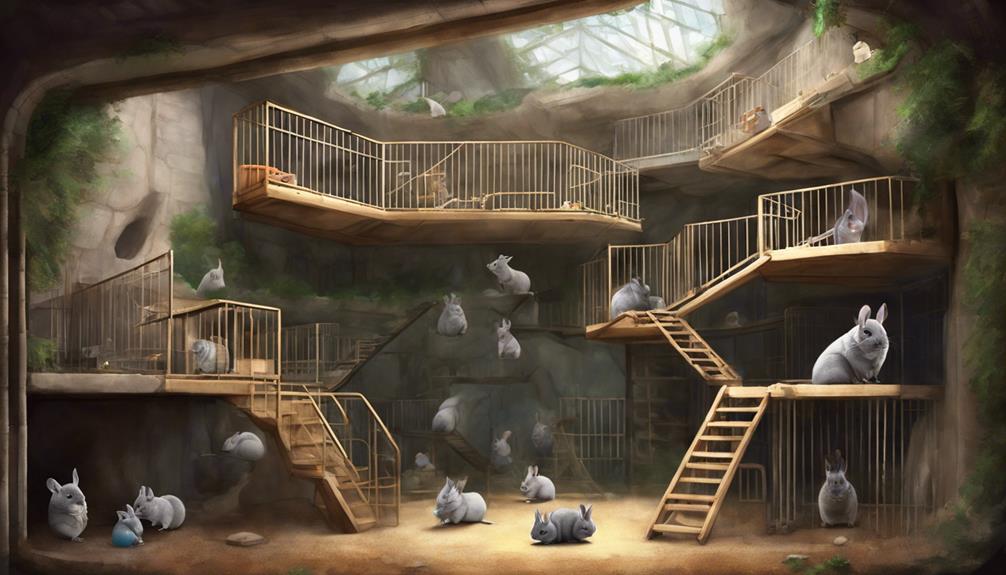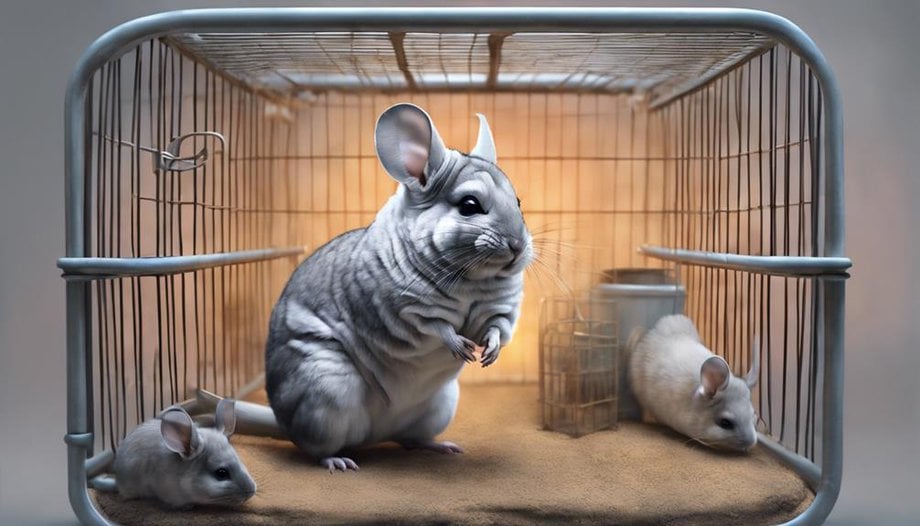When to Upgrade Your Chinchilla's Cage for Their Growth Stages

If you have a chinchilla, it's essential to provide a suitable cage that meets their needs. As your chinchilla grows, you may need to upgrade their cage to accommodate their changing size and requirements. Young chinchillas may start in a smaller cage, but as they grow, they will need more space to move around and exercise. A larger cage also allows for the addition of more toys and accessories to keep your chinchilla mentally stimulated and happy. Keep an eye on your chinchilla's behavior and monitor if they seem cramped or restless in their current cage. If you notice any signs of discomfort or if your chinchilla is outgrowing their current living space, it's time to consider upgrading to a larger cage. Remember, a spacious and enriching environment is crucial for your chinchilla's health and well-being.
By providing an appropriate cage size for each growth stage, you can ensure that your chinchilla remains healthy and content throughout its life.
Key Takeaways
- Provide ample space for growth and exploration to accommodate your chinchilla's development.
- Incorporate entertainment accessories and enrichment items to support their mental and physical well-being.
- Implement safety measures for juniors and seniors to ensure a secure environment.
- Plan for future growth to avoid frequent cage upgrades and to meet their evolving needs.
Cage Size for Baby Chinchillas
When raising baby chinchillas, it's essential to provide a cage that offers ample space for their growth and exploration. Cage accessories such as hammocks, ledges, and tunnels can provide entertainment and stimulation, important for their development. Playtime is important for baby chinchillas, as it not only helps them expend energy but also aids in their socialization skills.
Additionally, incorporating chew toys into the cage is necessary for their dental health and mental enrichment. These toys not only satisfy their natural chewing instincts but also provide a form of exercise, keeping them active and engaged. As they grow, it's important to introduce various toys and accessories that encourage movement and play.
Creating a dynamic environment within the cage will help baby chinchillas thrive and lead to healthier, happier adults. Regular exercise and playtime are fundamental aspects of their care, ensuring they remain physically and mentally stimulated as they mature.
Cage Modifications for Juveniles
As juvenile chinchillas grow, modifying their cage is crucial for accommodating their changing needs. Ensuring the cage size is suitable for young chinchillas and implementing safety features for juniors are key aspects to focus on.
These adjustments won't only keep your chinchilla safe but also provide them with a comfortable and stimulating environment to thrive in.
Size for Young Chinchillas
Young chinchillas require a spacious cage to accommodate their playful nature and growing bodies. As these adorable creatures are in their juvenile stage, providing them with enough space to move around and play freely is vital. Monitoring their growth is key as it will dictate when adjustments to their cage size are needed. Below is a helpful table to guide you on the ideal cage sizes for young chinchillas:
| Chinchilla Age | Minimum Cage Size |
|---|---|
| 2-4 months | 2' x 2' |
| 4-6 months | 2' x 3' |
| 6-12 months | 2' x 4' |
| 12+ months | 3' x 3' |
Safety Features for Juniors
Enhancing the cage with safety features tailored for juvenile chinchillas can provide a secure and stimulating environment for their growth and development. When considering safety precautions and growth considerations for young chinchillas, there are several modifications that can be made to the cage:
- Soft Bedding: Guarantee the bedding is soft to prevent injuries.
- Secure Platforms: Install platforms securely to prevent falls.
- Safe Chew Toys: Provide safe chew toys to satisfy their chewing instincts.
- Proper Ventilation: Guarantee good airflow to support their respiratory health.
- Non-Toxic Materials: Use only non-toxic materials in the cage to prevent poisoning risks.
Upgrading for Adolescent Chinchillas

During the adolescent stage, chinchillas may require a larger cage to accommodate their growing size and energy levels. As these furry companions shift into adolescence, their need for space and stimulation increases. Providing them with a spacious environment not only guarantees their physical comfort but also supports their mental well-being. Adolescent chinchillas are full of vigor and curiosity, exploring their surroundings with enthusiasm. To cater to their developmental needs, consider upgrading their cage and enriching it with various accessories and toys to keep them active and engaged.
| Cage Upgrades | Benefits |
|---|---|
| More vertical space | Encourages climbing |
| Additional shelves | Creates more play areas |
| Exercise wheel | Promotes physical activity |
| Chew toys | Helps maintain dental health |
| Hideouts | Provides a sense of security |
Cage Space for Young Adults
When considering cage space for young adult chinchillas, it's important to make sure the size is adequate for their comfort and well-being. Taking into account their increased activity levels at this stage of life is essential for their overall happiness and health.
Additionally, planning for their future growth now can prevent the need for frequent upgrades in the near future.
Size for Young Adults
Young adult chinchillas require ample cage space to move around comfortably and engage in their natural behaviors. To cater to their needs, here are some key considerations:
- Space Utilization: Optimize the layout to provide various levels and platforms for your chinchilla to explore.
- Cage Accessories: Include items like ledges, hammocks, and hanging toys to encourage activity and play.
- Enrichment: Incorporate items such as chew toys, tunnels, and exercise wheels to keep your chinchilla mentally stimulated.
- Ventilation: Make sure the cage has proper airflow to maintain a healthy environment for your pet.
- Privacy Areas: Include hideouts or cozy corners where your chinchilla can retreat when seeking solitude.
Activity Levels Considered
To guarantee young adult chinchillas thrive in their environment, it's essential to contemplate their activity levels when determining the appropriate cage space. Understanding their need for movement and mental stimulation is key. Providing various exercise options within the cage, like platforms, tunnels, and wheels, can keep them active and engaged.
Additionally, incorporating a consistent playtime routine outside the cage can further enhance their well-being. When deciding between indoor versus outdoor play, consider safety and weather conditions. Enrichment activities such as hiding treats, introducing new toys, or creating obstacle courses can promote physical and mental health.
Future Growth Planning
Future growth planning for chinchillas involves thoughtful consideration of their evolving spatial requirements as they mature. Chinchilla owners must anticipate their pets' growth to make sure they provide adequate space for their young adults. To plan for the future, consider the following:
- Regular Growth Monitoring: Keep track of your chinchilla's size to predict when they'll need more space.
- Cage Space Adjustments: Be prepared to upgrade the cage to accommodate their increasing size.
- Future Planning: Think ahead and invest in a cage that will suit your chinchilla as they reach adulthood.
- Size Considerations: Make sure the cage dimensions are suitable for a fully grown chinchilla.
- Room for Activity: Provide enough room for your chinchilla to exercise and play comfortably.
Ensuring Comfort for Adult Chinchillas
Ensuring the comfort of adult chinchillas in their cages is essential for their overall well-being and happiness. When it comes to comfort priorities, space considerations play a critical role in allowing adult chinchillas to move around freely. Additionally, cage enrichment is crucial for meeting adult needs, providing mental stimulation and preventing boredom.
| Comfort Priorities | Space Considerations | Cage Enrichment |
|---|---|---|
| Soft Bedding | Adequate Room | Chew Toys |
| Dust Bath Area | Vertical Space | Exercise Wheel |
| Hideout | Play Areas | Wooden Blocks |
| Nesting Box | Multiple Levels | Hanging Toys |
| Climbing Ledges | Resting Platforms | Tunnel Systems |
Cage Safety for Mature Chinchillas

Adult chinchillas' safety within their cages is paramount, particularly as they age and require specific considerations for their well-being. As chinchillas mature, their needs change, and making certain their environment is safe becomes even more critical.
Here are some key aspects to focus on:
- Cage ventilation: Adequate airflow is essential for mature chinchillas to prevent respiratory issues. Confirm the cage has proper ventilation to keep the air fresh and clean.
- Flooring options: Choose flooring that's gentle on their delicate feet. Avoid wire-bottomed cages and opt for solid surfaces or fleece liners to protect their paws.
- Secure locks: As chinchillas become more curious, ensure cage doors have secure locks to prevent any escape attempts.
- Chew-proofing: Mature chinchillas may continue their chewing habits, so make certain all cage materials are safe and non-toxic if ingested.
- Regular inspections: Check the cage frequently for any wear and tear, loose parts, or potential hazards to keep your chinchilla safe and sound.
Final Cage Upgrades for Seniors
As chinchillas age, their habitat needs finessing to cater to their changing requirements and guarantee their comfort and safety. When it comes to senior chinchilla care, final cage upgrades play an important role in maintaining their well-being. Consider providing softer bedding to cushion their joints and make sure their comfort. Opt for low-entry feeding and watering stations to accommodate any mobility issues they may develop. Additionally, incorporating more resting platforms and ramps can help senior chinchillas navigate their space with ease, promoting both mental and physical stimulation.
Comfort considerations are paramount for senior chinchillas, so make sure that the cage is well-ventilated and draft-free. Regularly check for wear and tear in the cage structure to prevent any accidents or injuries. Health maintenance is also key during this stage, so placing chew toys strategically around the cage can help maintain dental health. By making these final cage upgrades, you can create a safe and comfortable environment that supports your senior chinchilla's overall well-being.
Frequently Asked Questions
Can Chinchillas of Different Growth Stages Be Housed Together in the Same Cage?
Chinchillas of different growth stages should not be housed together in the same cage due to varying housing dynamics. It's important to prioritize cage compatibility and socialization for the well-being of these furry friends.
How Often Should the Cage Be Cleaned and Sanitized for Chinchillas of Different Ages?
Chinchilla owners should clean and sanitize their cages regularly to maintain a healthy environment for chinchillas of all ages. It is essential to establish a consistent schedule for cage maintenance to guarantee the well-being of these adorable pets.
Are There Any Specific Toys or Accessories That Are Recommended for Chinchillas at Each Growth Stage?
Chinchillas thrive with age-appropriate toys and accessories. Enrichment activities and exercise options keep them active and healthy. Grooming supplies cater to their unique needs. Dietary requirements shift with growth stages, ensuring prime care.
How Can I Prevent Territorial Behavior When Introducing a New Chinchilla to an Existing Group in the Cage?
To prevent territorial behavior when introducing a new chinchilla, employ training techniques and behavior modification. Focus on group dynamics and socialization strategies. Gradually acclimate them in a neutral space, use positive reinforcement, and monitor interactions closely for a harmonious integration.
What Are Some Signs That Indicate It's Time to Upgrade to a Larger Cage for Chinchillas of Different Growth Stages?
When chinchillas begin to resemble contortionists trying to squeeze into their cage or start treating their home like a high-speed obstacle course, it might be time for a larger abode. Happy chinchillas need space to roam and play freely.











